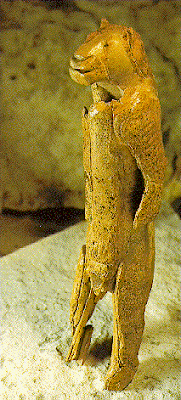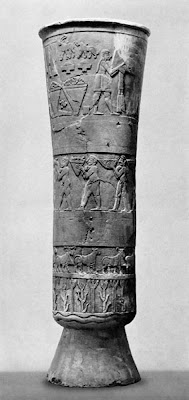Early sculpture: the Lion-Man
 The "Lion Man" from Hohlenstein-Stadel
The "Lion Man" from Hohlenstein-StadelHeigth 28 cm, about 6 cm diameter. Made of mammouth ivory
Found in the cave of Hohlenstein-Stadel in the Valley of Lone,
Baden-Württemberg (Germany).
Dated as Aurignacien, about 30,000 years ago
source: http://home.bawue.de/~wmwerner/english/lionlady.html
The Lion Man (also referred to as Lion Woman, for the lack of specific sexual attributes in the statuette) is the “ancestor” of Mickey Mouse and of all the anthropomorphic animal creatures of folk- tales and fairy-tales around the world, as well as religious symbols (for instance, in Egyptian art and religion), totemic figures and emblems, etc.
Anthropomorphic images propose correlations between the human world and the world of animals. These correlations may be considered as purely intellectual, that is belonging to the sphere of the symbolic, of socio-cultural taxonomies, of language games, etc. They may, alternatively, be related to the metaphysical sphere of a “savage ontology” and a native cosmic anthropology. Or they may refer to both: to the intellectual operations and communicative strategies of early man and of modern “primitives”, and to the apprehension of the structures of reality itself, that is, to a world in which the separation between knowledge and belief has not yet taken place. In fact: a world in which that separation cannot take place for it will amount to the destruction of the (cosmic) order of communication that constitutes, indeed, the stuff of reality.
Anthropomorphism is an important element in shamanic belief-systems and cultures. The practices and beliefs of shamanism as a key to the understanding of prehistoric art is an idea developed and applied by Lewis-Williams, Clottes, and other contemporary researchers.
M.G. Lima
Anthropomorphic images propose correlations between the human world and the world of animals. These correlations may be considered as purely intellectual, that is belonging to the sphere of the symbolic, of socio-cultural taxonomies, of language games, etc. They may, alternatively, be related to the metaphysical sphere of a “savage ontology” and a native cosmic anthropology. Or they may refer to both: to the intellectual operations and communicative strategies of early man and of modern “primitives”, and to the apprehension of the structures of reality itself, that is, to a world in which the separation between knowledge and belief has not yet taken place. In fact: a world in which that separation cannot take place for it will amount to the destruction of the (cosmic) order of communication that constitutes, indeed, the stuff of reality.
Anthropomorphism is an important element in shamanic belief-systems and cultures. The practices and beliefs of shamanism as a key to the understanding of prehistoric art is an idea developed and applied by Lewis-Williams, Clottes, and other contemporary researchers.
M.G. Lima
 Cave of Hohlenstein-Stadel
Cave of Hohlenstein-Stadel source: http://www.ice-age-art.de/anfaenge_der_kunst/hohlen.php


Comments